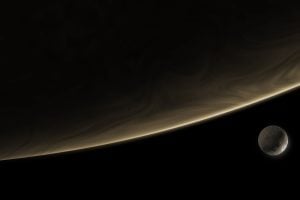
As Europa (the smallest of four moons orbiting Jupiter) is considered one of the solar system’s primary candidates for hosting extraterrestrial life, Vila developed the Europa Water and Geological Research, Observation, and Surveying System (EW-GROSS) rover. Equipped with a communication subsystem that can transmit data and images of Europa to Earth, the system could be used for analyzing samples for signs of life on another world.
How did this problem come to your attention?
I am a huge space buff and have always been interested in discoveries from the Mars rover missions, Hubble Space Telescope, and the new James Webb Space Telescope, so I was intrigued by the possibility of developing a system that could yield similar discoveries. Scans from the Voyager mission in the 1970’s and from the Galileo spacecraft suggest that there may be liquid water—an essential requirement for sustaining life—underneath Europa’s icy surface. A mission that could land on the surface of Europa would be able to definitively prove whether liquid water lays beneath the surface and whether life exists there. Based on this information, I started forming the initial problem set for the Europa Water and Geological Research, Observation, and Surveying System (EW-GROSS) rover.
Fun fact: I had originally come up with this project during the Introduction to Systems Engineering course at Hopkins. I really enjoyed the initial work on EW-GROSS, so I was eager to complete this project to close out my master’s in Systems Engineering.
How did you use a systems engineering approach in creating your system?
The first step was to conduct as much research on the project as possible. I also reached out to contacts at NASA’s Goddard Space Flight Center and Jet Propulsion Laboratory, and also worked with Joshua Savitt, chief advanced missions systems engineer at Raytheon Technologies and JHU’s contact for Space Systems, to interview potential stakeholders. Fortunately, I had the honor to interview Bethany Theiling, a Goddard expert on ocean worlds, who provided beneficial insight and advice.
Next, I built the initial set of requirements for the project and started on the functional analysis. Then, I built my conceptual design, created a test plan for the integration and qualification testing of the rover, and closed out the project with my report and presentation. I was very fortunate to have a fantastic mentor, Bob Krzystan, senior advisory engineer at Northrop Grumman Corporation and Engineering for Professionals faculty member, who helped guide me at each deliverable to ensure I followed the systems engineering process and that I properly traced my requirements throughout the project.
What is your solution? How does it do the job better than systems already in use?
I created the EW-GROSS rover, which contains multi-subsystems and sensors that can ultimately communicate and transmit data to and from Earth, provide imaging of the rover’s surroundings on Europa, and analyze samples of the Europa surface for signs of life as well as chemical composition.
In addition, unlike other probe concepts that have been explored for Europa, this system will be able to navigate on Europa’s surface. This will be beneficial for the collection of sampling data on both the surface and subsurface of the moon.
Why is this work important? Do you see your solution working in real life?
As Europa is a top candidate for life on worlds other than Earth, it would be extremely beneficial to have a rover on its surface to discover if there is any life teeming below the surface. The Mars rovers have yielded 20 years of breakthroughs in our understanding of Mars, and I would expect this system to yield similar discoveries. There are sizeable challenges to this project, however. The Europa environment requires significant amounts of radiation shielding and thermal protection on the rover. These protections may be too heavy or cumbersome to integrate, which may require the sensor systems to be scaled down. Another challenge is maneuvering on Europa. With the limited imagery available of the Europa surface, it is difficult to know exactly what the terrain is like on the surface and whether a rover would be able to effectively maneuver on the surface.
Will you continue to work on this project?
The next steps are to determine the level of applicability for radiation, thermal, and vacuum protection, investigation into the viability of consolidating the various computer components into a single computing subsystem, continuous refinement of maneuverability risks with updated imagery of Europa, continuous refinement of the software requirements for EW-GROSS, and starting early development of the RoverSim tool. The RoverSim, a proposed simulation tool, would be designed to model the environment on Europa’s surface to test EW-GROSS functionality.
I would love the opportunity to refine this project. I have provided my report to NASA Goddard to see if there are any aspects of the project that could be built upon. Unfortunately, I expect this system to remain in conceptual design for the near future.
How have your studies in the Systems Engineering program played a role in the project development?
The Systems Engineering curriculum at JHU set me up for success on this project. The Systems Engineering process helped break down what was a very large task into manageable portions to then refine during continuous requirement development, functional analysis, and conceptual design. It became very clear during the project how the systems engineering process is iterative at each level of the design, which was something that the instructors at JHU emphasized in each class.
Finally, I sincerely appreciated the push for Model-Based Systems Engineering (MBSE) in the JHU curriculum. MBSE, a methodology that emphasizes the use of computer models to support requirements associated with developing complex systems, allowed me to effectively manage my project and maintain traceability from requirements to conceptual design. As more agencies adopt MBSE, this skill will prove valuable in my professional development.